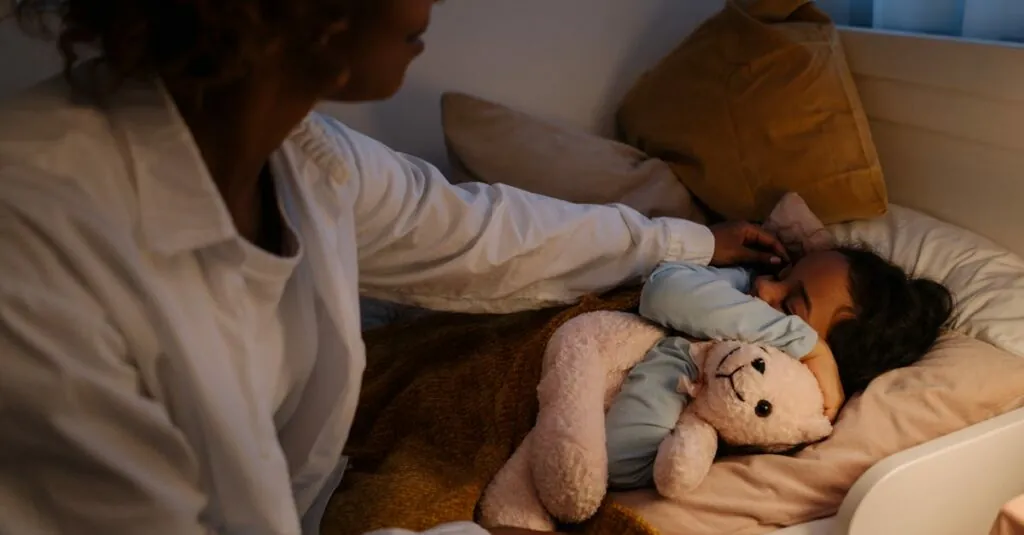Every parent knows that the journey to dreamland can be a wild ride, often filled with giggles, tears, and the occasional negotiation over bedtime snacks. But when it comes to the age-old question of when kids can sleep with stuffed animals, the answers can be as fuzzy as those beloved toys themselves. Are they just cute companions, or do they hold the secret to a peaceful night’s sleep?
Stuffed animals aren’t just for cuddles; they can be essential for a child’s emotional development. From providing comfort during scary bedtime moments to sparking imaginative adventures, these plush pals play a crucial role in a child’s life. So, when’s the right time to introduce these fuzzy friends into the bedtime routine? Let’s dive into the delightful world of stuffed animals and discover how they can transform bedtime from a battle into a blissful experience.
Table of Contents
ToggleUnderstanding Child Development Stages
Stuffed animals play a significant role in children’s sleep habits across different stages of development. Understanding these stages helps determine when introducing stuffed animals might be beneficial.
Infants and Sleep Safety
Infants thrive in safe sleeping environments. The American Academy of Pediatrics recommends keeping the crib free of soft objects, including stuffed animals, to prevent suffocation risks. Parents can provide comfort through touch or sounds, while waiting until six months before introducing a small, safe stuffed animal. Introducing a toy only after infants can move independently ensures a safer sleeping experience.
Toddlers Exploring Comfort
Toddlers begin to seek comfort objects as part of their emotional development. Between ages one and three, a stuffed animal can provide reassurance during bedtime, helping ease separation anxiety. Choices regarding size and softness matter. Selecting a smaller, plush toy ensures it’s safe for nighttime cuddling. Observing a toddler’s attachment to a specific stuffed animal can clarify their emotional needs and promote a sense of security.
Benefits of Sleeping with Stuffed Animals
Sleeping with stuffed animals offers various advantages for children. The comfort and emotional support these toys provide can significantly impact a child’s well-being.
Emotional Support and Security
Stuffed animals serve as reliable sources of emotional support. Their presence creates a sense of security, allowing kids to navigate bedtime with confidence. Children often find solace in holding their favorite stuffed companions during moments of fear or anxiety. This attachment can help children process emotions and build resilience. Familiarity with a specific stuffed animal reinforces the comfort they feel, contributing to a more restful sleep. Observing a child cuddle with their beloved toy often signals a healthy emotional connection.
Enhancing Imagination and Play
Stuffed animals stimulate creativity and imaginative play. These toys become characters in storytelling, fostering a child’s ability to invent scenarios and engage in role-playing. Through interactions with stuffed animals, kids explore various social situations, enhancing their communication skills. Such imaginative play promotes cognitive development by encouraging problem-solving and decision-making. As children concoct adventures with these toys, they also develop empathy, learning to care for their friends in the process. Overall, stuffed animals play a crucial role in both emotional growth and cognitive advancement.
When Can Kids Sleep with Stuffed Animals?
Stuffed animals can significantly enhance a child’s bedtime experience. Determining the right time for kids to sleep with them varies based on developmental stages.
Age Recommendations
Infants should not sleep with stuffed animals before reaching six months of age, prioritizing safety to avoid suffocation risks. After this age, many children begin to feel comforted by toys. For toddlers aged one to three, stuffed animals become essential comfort objects, helping to alleviate separation anxiety. Choosing toys that are appropriately sized and soft supports nighttime safety. Kids aged four and older may incorporate stuffed animals as part of their imaginative play, further enhancing their sleep routines.
Assessing Child Readiness
Evaluating a child’s readiness for sleeping with stuffed animals requires observing their attachment to specific toys. Kids showing emotional connections tend to benefit most. Comfort preferences in sleep can indicate readiness for stuffed animal companionship. Monitoring nighttime behavior helps determine if a child uses stuffed animals as a security measure. If they express a desire for a particular toy when anxious or scared, it’s typically a signal of emotional dependence, suggesting it’s time to introduce these comforting companions into their bedtime routine.
Potential Concerns and Considerations
When children sleep with stuffed animals, several concerns may arise.
Allergies and Safety Issues
Parents should consider potential allergies that stuffed animals may trigger. Common allergens include dust mites and certain fabrics. Choosing hypoallergenic materials can minimize these risks. Regular washing of stuffed animals fosters a clean sleeping environment. Additionally, safety issues should guide decisions about stuffed animal size and substance. Small parts could pose choking hazards for younger children. Avoiding overly large or heavy toys helps ensure a safe sleep setting, particularly for infants. Maintaining a safe space is crucial for promoting healthy sleep habits.
Nighttime Dependency
Nighttime dependency may develop if children rely too heavily on stuffed animals for comfort. Excessive attachment could lead to difficulties when the toy is absent. Helping children establish sleep routines that don’t solely involve stuffed animals encourages self-soothing skills. Exploring other comfort strategies, such as blankets or nighttime rituals, can provide alternatives. Fostering independence typically leads to a smoother transition into sleep, ensuring children feel secure without constantly needing their stuffed toys. Balancing comfort and independence benefits emotional growth and nighttime habits.
Stuffed animals can play a vital role in a child’s sleep routine. They offer comfort and security while helping children navigate their emotions. Understanding the right time to introduce these toys is crucial for ensuring safety and emotional growth.
As children develop, their attachment to stuffed animals can enhance their bedtime experience. Parents should remain mindful of their child’s needs and preferences when selecting the right companion. Balancing comfort with safety and independence is key to fostering healthy sleep habits. Ultimately, stuffed animals can transform bedtime from a struggle into a peaceful and imaginative experience.





